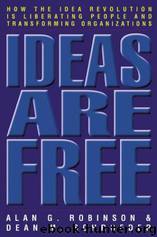Ideas Are Free by Alan G. Robinson & Dean M. Schroeder

Author:Alan G. Robinson & Dean M. Schroeder [Robinson, Alan G. & Schroeder, Dean M.]
Language: eng
Format: epub
Tags: Human Resources & Personnel Management, Management, Management - Employee participation, Organizational Behavior, Motivational, Corporate culture, Organizational change, Suggestion systems, Employee participation, Organizational effectiveness, Business & Economics
ISBN: 9781576752821
Publisher: Berrett-Koehler Publishers
Published: 2004-02-15T08:00:00+00:00
MAKING IDEAS PART OF THE WORK OF SENIOR LEADERS
Bruce Hertzke, CEO of Winnebago Industries, almost never travels on Fridays. Friday mornings are reserved for a special morning coffee gathering of all those who have had an idea implemented during the previous week, together with their managers. As the suggesters arrive, they are photographed with Hertzke. These photographs are published in the next issue of the company newsletter along with a brief description of each idea.
When the meeting starts, each suggester is asked to describe his or her idea and its expected results. Hertzke comments on each idea and thanks the suggester. After all the ideas have been heard, the rest of the meeting is dedicated to an open discussion of any issues that the employees or their managers want to talk about.
Leaders who are serious about promoting employee ideas have to design a role for themselves in the process. The role need not take much time, but it should keep them informed about the idea system’s performance and put them in regular and personal contact with suggesters and their ideas. The leader’s personal involvement has two purposes. First is the obvious need for overseeing the process and showing support for it from the top. If ideas are important to the company, the CEO has to ensure that everyone knows this and that ideas are being managed effectively. With just one hour per week, Hertzke makes it clear to both employees and managers that ideas are important to him and the company.
The second reason for the CEO’s involvement is to increase his or her effectiveness. Hertzke is rare among CEOs in that he started at Winnebago as a teenager working on the assembly line. There he saw how he and his fellow workers were not listened to, though they had all kinds of ideas for improving products and processes. As a result, he is keenly aware that the nature of his job distances him from the issues and concerns of those on the front lines. For Hertzke, the Friday idea meetings are a priceless chance to stay in touch. Many leaders find it very difficult to know what is really happening in their organizations. For example, at a roundtable of business leaders we once presented to, the CEO of one of the world’s largest drug companies commented that the most challenging part of his job was getting good information about what was really going on in the organization. “People tend to tell me what they think I want to hear,” he said. “Sometimes I feel very out of touch.”
By hearing ideas, questions, and concerns directly from his employees every week, Hertzke stays in close touch with what is going on in his company and is regularly reminded that his people are a tremendous resource—they care about the company, are thoughtful and observant, and often see opportunities their managers do not. Many executives are quick to lay off employees to improve financial performance. But every company we are familiar with that operates a high-performing idea system is different.
Download
This site does not store any files on its server. We only index and link to content provided by other sites. Please contact the content providers to delete copyright contents if any and email us, we'll remove relevant links or contents immediately.
Tools of Titans by Timothy Ferriss(7806)
Change Your Questions, Change Your Life by Marilee Adams(7371)
Deep Work by Cal Newport(6562)
Man-made Catastrophes and Risk Information Concealment by Dmitry Chernov & Didier Sornette(5644)
Playing to Win_ How Strategy Really Works by A.G. Lafley & Roger L. Martin(5489)
Digital Minimalism by Cal Newport;(5388)
Big Magic: Creative Living Beyond Fear by Elizabeth Gilbert(5349)
The Slight Edge by Jeff Olson(5199)
The Motivation Myth by Jeff Haden(4997)
Ego Is the Enemy by Ryan Holiday(4950)
Stone's Rules by Roger Stone(4852)
The Laws of Human Nature by Robert Greene(4770)
Tuesdays with Morrie by Mitch Albom(4392)
Rising Strong by Brene Brown(4190)
Eat That Frog! by Brian Tracy(4147)
Skin in the Game by Nassim Nicholas Taleb(3965)
The Money Culture by Michael Lewis(3843)
Bullshit Jobs by David Graeber(3826)
Skin in the Game: Hidden Asymmetries in Daily Life by Nassim Nicholas Taleb(3720)
